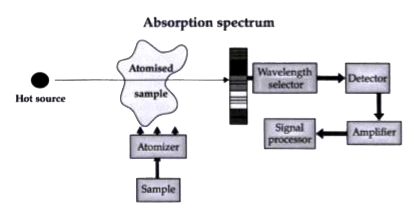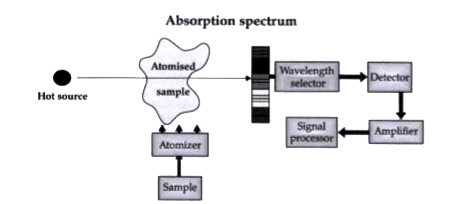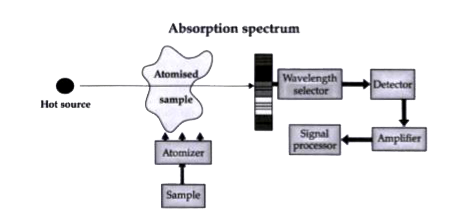During Z scheme, electrons excited by absorption of light if PS I are transferred to the primary acceptors, and tehrefore must bereplaced. The replacements come directly form
NADP
ATP
PS II
Water.
The correct Answer is:C
Step-by-Step Solution:
1. Understanding the Z Scheme: The Z scheme is a model that describes the light-dependent reactions of photosynthesis, particularly how light energy is converted into chemical energy through two photosystems: Photosystem II (PS II) and Photosystem I (PS I).
2. Role of Photosystem I (PS I): In PS I, light energy is absorbed, which excites electrons. These excited electrons are then transferred to a primary electron acceptor.
3. Need for Electron Replacement: Once the electrons are transferred from PS I to the primary acceptor, there is a need to replace these lost electrons in PS I to maintain the continuity of the electron transport chain.
4. Source of Replacement Electrons: The replacement electrons for PS I come directly from Photosystem II (PS II). PS II is responsible for the initial absorption of light energy and the splitting of water molecules.
5. Oxygen Evolving Complex (OEC): Within PS II, there is a component known as the Oxygen Evolving Complex (OEC). This complex contains enzymes that facilitate the splitting of water (H2O) into protons (H+), electrons (e-), and oxygen (O2).
6. Water Splitting Reaction: The reaction can be summarized as:
2H2O→4H++4e−+O2
The electrons released from this reaction are what replace the electrons lost from PS I.
7. Conclusion: Therefore, the electrons that replace those lost from PS I come directly from Photosystem II.
Final Answer: The replacements come directly from Photosystem II (PS II).
---
2H2O→4H++4e−+O2
The electrons released from this reaction are what replace the electrons lost from PS I.
Topper's Solved these Questions
Similar Questions
Assertion: The whole scheme of transfer of electrons, starting from the PS II uphill to the acceptor, down the electron transport chain to PS I, excitation of electrons, transfer to another acceptor, and finally downhill to NADP+ causing it to be reduced to NADPH+H+~iscal≤dtheZschemeorcyclicpho⊤hosphorylation.<br>Reason:BothATPandNADH+H^(+) are synthesised by this kind of electron flow.
View SolutionWhich one directly transfers electrons to NADP+ during light reaction?
View Solution
Knowledge Check
- Question 1 - Select One
During cyclic photophosphoylation energy rich electrons form PS-I are first transferred to ........
AFerredoxin reducing substanceBCytochromeCNADPDPrimary electron acceptor - Question 2 - Select One
The electrons, that are removed from photosystem-II and photosystem-I during z-scheme, must be replaced. This is achieved by electrons released
ABy photosystem-I NADP+BBy splitting of water and NADPHCBy ATP and photosystem-IIDBy splitting of water and photosystem-II - Question 3 - Select One
whole scheme of transfer of electrons , starting from the PS II, uphill to the acceptor, down the electron transport chain to PS I ,excitation of elecitations, transfer to another acceptor, and finally down hill to NADP+ causing it to be reducedd to NADPH+H+ is called
AOxidative phosphorylationBCycllic photophosphorylationCPCR cycleDZ-scheme
Select the incorrect statement from the following with regard to Z scheme of electron transport in light phase of photosynthesis. I0 The movement of electrons from pheophytin to P700 is downhill II) The transport of electrons from primary e-acceptor of PS-I to NADP+ is downhill III) OEC complex is associated with the PS-II and is physically located on the other side of the thylakoid membrane facing the stroma. IV) O2 is one of the net products of photosynthesis
View SolutionRead the following text and answer the following questions on the basis of the same:
Atomic Absorption Spectrometer: The atomic absorption (AA) spectrometer is used to analyze metals at very low concentrations, typically in the parts per million (ppm) or parts per billion (ppb) ranges. A liquid sample containing dissolved material whose concentration is to be measured is aspirated into a thin, wide AA flame, or is introduced into a small carbon furnace which is heated to a high temperature.

Basic Principle of AAS is the measurement of absorption of radiation by free atoms. The total amount of absorption depends on the number of free atoms present and the degreee to which the free atoms absorb the radiation. At the high temperature of the AA flame, the sample is broken down into atoms using an atomizer and it is the concentration of these atoms that is measured. Sample in the form of solution is used. It is broken up into a fine mist with the help of an atomizer. When the mist reaches the flame, the intense heat breaks up the sample into its individual atoms. When a photon coming out from the hot source hits an atom and the energy of the photon is equal to the gap between two electron energy levels of the atom, then the electron in the lower energy level absorb the photon and jumps up to the higher energy level. If the photon energy does not correspond to the difference between two energy levels, then the photon will not be absorbed (it may be scattered away). Hence in the spectrum, the wavelength corresponding to the absorbed photons is observed as black lines as shown in the following spectrum of Hydrogen. The dark lines correspon to the frequencies of light those have been absorbed by the sample element. Using this process, a source of photons (generally a white light) of various energies is used to obtain the absorption spectra of different materials and to identify them.
What should be the concentration of metal for analysis using Atomic Absorption Spectrometer?View SolutionRead the following text and answer the following questions on the basis of the same:
Atomic Absorption Spectrometer: The atomic absorption (AA) spectrometer is used to analyze metals at very low concentrations, typically in the parts per million (ppm) or parts per billion (ppb) ranges. A liquid sample containing dissolved material whose concentration is to be measured is aspirated into a thin, wide AA flame, or is introduced into a small carbon furnace which is heated to a high temperature.

Basic Principle of AAS is the measurement of absorption of radiation by free atoms. The total amount of absorption depends on the number of free atoms present and the degreee to which the free atoms absorb the radiation. At the high temperature of the AA flame, the sample is broken down into atoms using an atomizer and it is the concentration of these atoms that is measured. Sample in the form of solution is used. It is broken up into a fine mist with the help of an atomizer. When the mist reaches the flame, the intense heat breaks up the sample into its individual atoms. When a photon coming out from the hot source hits an atom and the energy of the photon is equal to the gap between two electron energy levels of the atom, then the electron in the lower energy level absorb the photon and jumps up to the higher energy level. If the photon energy does not correspond to the difference between two energy levels, then the photon will not be absorbed (it may be scattered away). Hence in the spectrum, the wavelength corresponding to the absorbed photons is observed as black lines as shown in the following spectrum of Hydrogen. The dark lines correspon to the frequencies of light those have been absorbed by the sample element. Using this process, a source of photons (generally a white light) of various energies is used to obtain the absorption spectra of different materials and to identify them.
What is the basic principle of Atomic Absorption Spectrophotometer?View SolutionRead the following text and answer the following questions on the basis of the same:
Atomic Absorption Spectrometer: The atomic absorption (AA) spectrometer is used to analyze metals at very low concentrations, typically in the parts per million (ppm) or parts per billion (ppb) ranges. A liquid sample containing dissolved material whose concentration is to be measured is aspirated into a thin, wide AA flame, or is introduced into a small carbon furnace which is heated to a high temperature.

Basic Principle of AAS is the measurement of absorption of radiation by free atoms. The total amount of absorption depends on the number of free atoms present and the degreee to which the free atoms absorb the radiation. At the high temperature of the AA flame, the sample is broken down into atoms using an atomizer and it is the concentration of these atoms that is measured. Sample in the form of solution is used. It is broken up into a fine mist with the help of an atomizer. When the mist reaches the flame, the intense heat breaks up the sample into its individual atoms. When a photon coming out from the hot source hits an atom and the energy of the photon is equal to the gap between two electron energy levels of the atom, then the electron in the lower energy level absorb the photon and jumps up to the higher energy level. If the photon energy does not correspond to the difference between two energy levels, then the photon will not be absorbed (it may be scattered away). Hence in the spectrum, the wavelength corresponding to the absorbed photons is observed as black lines as shown in the following spectrum of Hydrogen. The dark lines correspon to the frequencies of light those have been absorbed by the sample element. Using this process, a source of photons (generally a white light) of various energies is used to obtain the absorption spectra of different materials and to identify them.
What happens when a photon hits an atom and the energy of the photon is not equal to the gap between two electron energy levels of the atom?View SolutionRead the following text and answer the following questions on the basis of the same:
Atomic Absorption Spectrometer: The atomic absorption (AA) spectrometer is used to analyze metals at very low concentrations, typically in the parts per million (ppm) or parts per billion (ppb) ranges. A liquid sample containing dissolved material whose concentration is to be measured is aspirated into a thin, wide AA flame, or is introduced into a small carbon furnace which is heated to a high temperature.

Basic Principle of AAS is the measurement of absorption of radiation by free atoms. The total amount of absorption depends on the number of free atoms present and the degreee to which the free atoms absorb the radiation. At the high temperature of the AA flame, the sample is broken down into atoms using an atomizer and it is the concentration of these atoms that is measured. Sample in the form of solution is used. It is broken up into a fine mist with the help of an atomizer. When the mist reaches the flame, the intense heat breaks up the sample into its individual atoms. When a photon coming out from the hot source hits an atom and the energy of the photon is equal to the gap between two electron energy levels of the atom, then the electron in the lower energy level absorb the photon and jumps up to the higher energy level. If the photon energy does not correspond to the difference between two energy levels, then the photon will not be absorbed (it may be scattered away). Hence in the spectrum, the wavelength corresponding to the absorbed photons is observed as black lines as shown in the following spectrum of Hydrogen. The dark lines correspon to the frequencies of light those have been absorbed by the sample element. Using this process, a source of photons (generally a white light) of various energies is used to obtain the absorption spectra of different materials and to identify them.
How the sample for analysis is deriven to atomic state in AAS?View Solution

